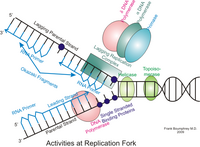
Photo from wikipedia
The Ku70/80 heterodimer binds to DNA ends and attracts other proteins involved in the non-homologous end-joining (NHEJ) pathway of DNA double-strand break repair. We developed a novel assay to measure… Click to show full abstract
The Ku70/80 heterodimer binds to DNA ends and attracts other proteins involved in the non-homologous end-joining (NHEJ) pathway of DNA double-strand break repair. We developed a novel assay to measure DNA binding and release kinetics using differences in Förster resonance energy transfer (FRET) of the ECFP-Ku70/EYFP-Ku80 heterodimer in soluble and DNA end bound states. We confirmed that the relative binding efficiencies of various DNA substrates (blunt, 3 nucleotide 5′ extension, and DNA hairpin) measured in the FRET assay reflected affinities obtained from direct measurements using surface plasmon resonance. The FRET assay was subsequently used to investigate Ku70/80 behavior in the context of a DNA-dependent kinase (DNA-PK) holocomplex. As expected, this complex was much more stable than Ku70/80 alone, and its stability was influenced by DNA-PK phosphorylation status. Interestingly, the Ku80 C-terminal extension contributed to DNA-PK complex stability but was not absolutely required for its formation. The Ku70 C-terminal SAP domain, on the other hand, was required for the stable association of Ku70/80 to DNA ends, but this effect was abrogated in DNA-PK holocomplexes. We conclude that FRET measurements can be used to determine Ku70/80 binding kinetics. The ability to do this in complex mixtures makes this assay particularly useful to study larger NHEJ protein complexes on DNA ends.
Journal Title: International Journal of Molecular Sciences
Year Published: 2020
Link to full text (if available)
Share on Social Media: Sign Up to like & get
recommendations!